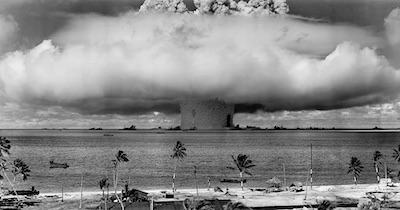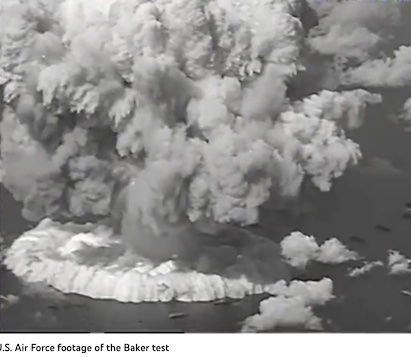
Bikini Atoll is a coral island in the Pacific Ocean, consisting of a ring-shaped reef surrounding a 25-mile by 15-mile oval lagoon. The atoll includes 23 small coral islands within its reef.
The atoll is part of the Marshall Islands, which is an island chain located between Hawaii and the Philippines. The United States government took administrative control of the Marshall Islands from Japan in 1944, and retained control until 1986, when the islands gained their independence. Today, the Republic of the Marshall Islands is a sovereign nation in free association with the United States.
Bikini Atoll History: Nuclear Test Site

While the Marshall Islands were officially under the purview of the U.S., the area became known as the Pacific Proving Grounds due to the nuclear testing conducted at various sites in the islands between the mid-1940s and early 1960s.
Bomb testing in the islands began in 1946, just after World War II ended and as the U.S. was on the cusp of what would later be dubbed the Cold War with the Soviet Union (the Union of Soviet Socialist Republics, or U.S.S.R.). The use of atomic weapons in Hiroshima and Nagasaki did more than end World War II – it inspired the burgeoning nuclear arms race.
The U.S. tested more than 20 nuclear devices at Bikini Atoll and nearby Enewetak Atoll.
Residual radioactivity remains today at Bikini Atoll.
As a part of the Compact of Free Association with the Marshall Islands, the U.S. government has agreed to resolve personal illness claims arising from its nuclear testing in the area. As a result of this, a federal program has been established by Congress that seeks to compensate veterans who participated in atmospheric nuclear testing conducted on Bikini Atoll or Enewetak Atoll between 1946 and 1958. MORE

It never rains on Bikini Atoll.
It pours, man. It pours.
Now do the history of Nothing Atoll.
And then there’s always Damn Atoll and for the Baptists Gosh Darn Atoll.
I prefer the no bikini atoll.
I discovered Bikini Atoll.
And I named the ladies’ swim suit I designed for it.
I just watched a two hour special on this on the Smithsonian Channel.
We did nuke the poor innocent bastards, so might as well care for them.
It’s an itsy-bitsy teeny weenie totally effed up Atoll.
Don’t go there.
I shudder to think of the billions of fish that were nuked.
Fish are people too, ya know.